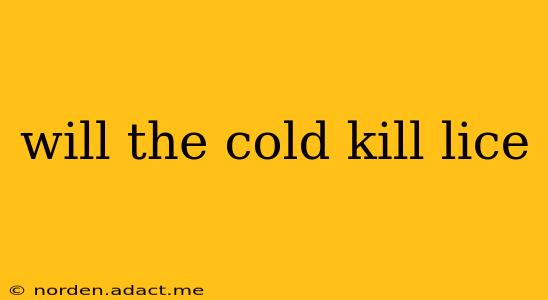Will the Cold Kill Lice? Understanding the Effects of Temperature on Lice
Lice infestations are a common problem, causing significant discomfort and itching. Many people wonder if cold temperatures can be used as a method of lice removal. While the answer isn't a simple yes or no, understanding the effects of cold on lice can help inform your approach to treatment.
What are Lice and How Do They Survive?
Head lice are tiny parasitic insects that feed on human blood. They thrive in warm environments and are highly contagious. Their survival is directly linked to their host's body temperature. This is crucial when considering the impact of cold temperatures.
Will Freezing Kill Lice?
The short answer is: it's complicated. While prolonged exposure to extremely low temperatures can kill lice, it's not a reliable or practical method of treatment. Simply placing an infested head in a cold environment won't eliminate the infestation.
The challenge lies in achieving the necessary low temperature for a sufficient duration to kill both adult lice and their eggs (nits). The temperature needs to be significantly below freezing for a considerable time to be effective. This makes this method impractical and potentially harmful.
What Temperatures Kill Lice?
Research suggests that temperatures below 0°C (32°F) for extended periods are needed to kill adult lice. However, this temperature is not easily achieved or maintained on a human head safely. Furthermore, nits (lice eggs) are more resistant to temperature changes than adult lice. They require even more extreme and prolonged cold to be eliminated.
Can Cold Air Kill Lice?
Simply being outside in cold weather will not kill lice. The temperature needs to be extremely low and consistently maintained for a long period. Cold air may offer some minimal discomfort to the lice, but it's highly unlikely to eliminate an infestation.
Are There Safe and Effective Treatments for Lice?
Instead of relying on potentially dangerous methods like extreme cold, several safe and effective treatments are available. These include:
- Over-the-counter lice shampoos: These contain pesticides that kill lice. Always follow the instructions carefully.
- Prescription medications: For persistent infestations, a doctor may prescribe stronger medications.
- Wet combing: This involves using a fine-toothed comb to remove lice and nits from wet hair. This method is time-consuming but effective.
It’s essential to consult a doctor or dermatologist for the best course of action. They can recommend effective treatments and strategies to deal with lice infestations safely and effectively. Do not attempt to treat lice with freezing temperatures, as it is both ineffective and potentially dangerous.
Other Myths About Lice Treatment:
Many misconceptions surround lice treatment. Some methods, like using mayonnaise or suffocating them with olive oil, are ineffective and may delay proper treatment, potentially worsening the infestation. Always seek professional advice for the most appropriate and effective treatment.
By understanding the realities of lice survival and effective treatment options, you can effectively address and resolve lice infestations without resorting to unproven or dangerous methods. Remember to always consult a healthcare professional for personalized advice and treatment.
